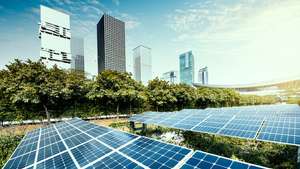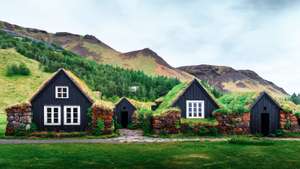
Eco-design: the methodological approach in designing.
 Anait Daniielian 1*
Anait Daniielian 1*
1Architectural Structures Department of Kyiv National University of Construction and Architecture.
Received: 06/01/2018, Accepted: 10/03/2018, Available online: 10/05/2018.
DOI: 10.32557/useful-2-3-2018-0004
*Corresponding author: e-mail: anait.daniyelyan@gmail.com, address: Povitroflotsky Avenue, 31, Kyiv, 03680 Ukraine
Under a creative commons license. Volume 2, Issue 3, 2018, pages: 15-28.
Author Keywords: eco-design, ecologization in design, structure ecologization, the life cycle of an object, the concept of functioning, the concept of ecologization of the object's functioning, eco-concept, geometry, the interaction between the object and environment, form-forming concept, geometrization, hierarchical model, composition, algorithm.
Abstract
A system of concepts and definitions was generalized, the basic principles of creating eco- objects are defined and formulated in the article. A model of the system representation of the eco-object is proposed to determine the concepts of environmental sustainability and structure ecologization. The concept of ecologization of the life cycle of the object is formulated, the appropriative scheme is proposed. The concept of ecologization of the object's functioning is presented. As a result of the structural analysis of the concept, three concepts of the functioning of the eco-object during the exploitation were formulated and highlighted. The factors that directly or indirectly influence decision-making in the process of shaping were systematized, formulated, presented in the schematic form. As a result of the dissertation research on the basis of analysis of examples from the design practice, systematization of data, development of the typology of objects of eco-architecture in terms of geometric schemes, constructive solutions and their interrelations, elaboration of a proposal for a new method of rational, multivariate use of ecological principles in the objects of different structure and purpose, the algorithm of modeling objects of eco-design as the basis of the decision-making system was developed.
Purpose
System research of concepts and constructive-geometric means of eco-objects designing; creation of methodical bases for the development of the corresponding decision-making system.
1. Introduction
The issue of preserving the natural environment for subsequent generations is caused by the rapid deterioration of the global environmental situation, the increase in the rate of global warming, the rising energy crisis as a result of increased consumption and construction in metropolises. Migration of the population and rapid development of the metropolises create the necessity of building large fields of functional complexes and high-rise buildings. Due to this, the issue of creating environmental objects became topical.
The design has become a sphere of human activity that offers solutions to global humanity problems, shaping a lifestyle and planning its future development. Since last few decades has seen a multifaceted and almost universal commitment to green design. Cities of the future, as represented by architects, are the concentration of a new ecologically responsible social order, technologies for the use of renewable energy sources and the rational use of natural resources. "Sustainable development" has become an extremely popular destination in all areas of human activity, in the architectural and construction industry and in particular in design.
In the field of design, there are such concepts as architectural and building bionics, Bio-architecture (bio-design), Bionics, Biotech, Eco-architecture, Eco-design, Eco-tech, Green building (green architecture, ecological building, etc.), Natural construction, Organic architecture (organic design), Sustainable development. However, a single glossary, conceptual apparatus as the basis for creating the theoretical basis for further system development of eco-direction in designing is not proposed. Further development of the industry requires the formulation of a single conceptual apparatus and the development of a methodology for designing of eco-objects.
Tools for designing eco-objects based on a systematic approach to design are proposed as a basis for the creation of a methodology for eco-design.
During the work on the dissertation "Instrumental tools for the creation of eco-design objects on the basis of a methodological approach", a system of concepts and definitions in the field of eco-design was generalized on the basis of a comprehensive analysis of research and design decisions in the field of eco-design [7], the basic principles of creating eco-design objects [1,2,3,4] are defined and formulated.
After analysis of design practice and theoretical material of different authors [13, 14, 15, 16, 17, 18, 19, 21, 22, 23] basic principles of eco-objects creating where formulated.
Basic principles of eco-objects creating:
1. Buildings with a closed loop of resources - objects in which different systems of recirculation and cyclic use of resources are applied:
- Systems and measures of water recirculation
- Systems and measures of energy recirculation
- Systems and measures of air circulation and purification
- Disposal and energy use systems of biological waste
2. Energy-intensive and energy-zero buildings are objects that provide their energy needs through the use of alternative energy sources without connecting to city electricity networks.
3. Objects that ecologize the environment, that is, improve the ecological state of the environment as a result of maximizing the positive effect of the object on the environment.
- Air: absorption of carbon dioxide and oxygen production; application of technologies and means of cleaning from harmful impurities; application of technologies and means of absorption and neutralization of radiation.
- Water: purification of reservoirs; desalination of water.
- Soils: enrichment, fortification, the rebirth of soils.
- Planting greenery: restoring the local flora; flora enrichment; creation of artificial flora.
4. Minimization of emissions and impacts:
- In the manufacture of materials
- During construction
- During operation
- In the process of dismantling
5. The objects which are isolated from the environment during the operation:
- Development of environments not foreseen for human life (underground, underwater skyscrapers, utopian space projects);
- Designing in an area with the unsatisfactory ecological situation (amount of harmful impurities in the air, radioactive background).
References
[1] Daniielian A. (2010). The essence of the implementa- tion of the principles of environmental friendliness in projects of eco-architecture. The Interdepartmental Col- lection of Proceedings. The industrial art and design. 8, - K .: KNUBA - P. 98-101. (in Ukrainian).
[2] Daniielian A., Bilous S. Eco-Architecture: Definition, Concepts, Objectives and Schemes of Realization. The Interdepartmental Collection of Proceedings. The indus- trial art and design. 9, - K .: KNUBA - P. 78-88. ISBN 5-8238-0731-7 (in Ukrainian).
[3] Ploskiy V. PhD, Daniielian A. (2011). Geometric princi- ples in the formatting of the ecology architecture’s ob- jectsSciences. Special Issue of the Proceedings of the Tau- rian State Agro-Technical University, Issue 4: Example on Geometry and Engineering Graphics, Vol. 50, Meli- topol, 2011. - P. 18-22. ISSN 2078-0877. (in Ukrainian).
[4] Daniielian A. Guidelines for implementing the methods of formation of concepts of eco-architecture. The Interde- partmental Collection of Proceedings. The industrial art and design. 10, - K .: KNUBA. P. 42-50. ISSN 2221-9293 (in Ukrainian).
[5] Daniielian A. (2013). Geometric model as a means of selecting the priority environmental factors taken into account during the design process of eco-architecture objects. Materials of the 3rd International Scientific and Practical Conference April 9-10, 2013, Bryansk, ”Problems of Innovative Biosphere-Compatible Socially economic development in the construction, housing and communal and road complexes ”. BGITA. Volume 2. P. 26-32. ISBN 978-5-98573-138-5 (in Russian).
[6] Daniielian A. (2016). Decision-making system for eco- objects designing. Scientific and technical collection ”Modern problems of architecture and urban planning”, issue 45. Kyiv: KNUBA. P. 36-44. (in Ukrainian).
[7] Ploskiy V. PhD, Daniielian A. (2017). Some features and principles of formation conceptual eco-design apparatus. The Interdepartmental Collection of Proceedings. The industrial art and design. 13, - K .: KNUBA. P. 130-135. ISSN 2221-9293 (in Ukrainian).
[8] Daniielian A. Implementation of the Systems Engineering Methodology of Eco-Design Object: Ecological Recon- struction of Lviv Square. (2018). Scientific and technical collection “Urban and territorial planning” issue 66. Kyiv: KNUBA. P. 123-133. ISSN 2076-815X.
[9] Daniielian A. (2018). Combinatorial models for analysis and generation of eco-objects geometry. Scientific and technical journal “Energy-efficiency in civil engineering and architecture”, issue 10 Kyiv: KNUBA. P. 85-95 (in Ukrainian).
[10] Myhailenko V., Yakovlev N. (2017). Basics of composi- tion. Textbook. - K.: Caravela. P. 304 (in Ukrainian).
[11] Golubeva O. L. (2004). Composition basics. textbook. - 2nd edition - M .: Art. P.120. (in Russian).
[12] Ikonnikov A., G. Stepanov. (1971). Fundamentals of ar- chitectural composition. Tutorial. M: Art. P. 225. (in Rus- sian).
[13] Bergman David. (2012). Sustainable Design: A Critical Guide (Architecture Briefs). NY: Princeton architectural press. 144 p.
[14] Williams Daniel E., Orr David W., Watson Donald. (2007). Sustainable Design: Ecology, Architecture, and Planning. Hoboken, New Jersey: John Wiley and Sons. 320 p.
[15] Yeang Ken. (2007). Eco skyscrapers. Ken Yeang,Ivor Richards. Australia: The Images Publishing Group Pty Ltd. third edition. P. 165.
[16] Engel Hiino. (2007). Bearing Systems - Moscow: AST: Astrel. P. 344. (in Russian).
[17] Al-Kodmany Kheir. (2016). New suburban: Sustainable tall building development. New York: Routledge. 283 p.
[18] Al-Kodmany Kheir (2015). Eco towers: Sustainable cities in the sky. Chicago: WIT Press. 483 p. ISBN-10:784660175
[19] Riba Hicham. Al-Kodmany Kheir. (2014). Innovative approaches to sustainable design: The riba green city model. Amazon Digital Services LLC. 241 p. ASIN:B00HUV525K
[20] Gissen David. (2003). Big and Green: Toward Sustainable Architecture in the 21st Century. New York: Prince- ton Architectural Press. 196 p. ISBN-10: 1568983611
[21] Lynn S. Beedle., Lynn S. Beedle, Mir M. Ali, Paul J. Armstrong. (2007). Skyscraper and the City Design, Tech- nology and Innovation, Book 1. NY: Edwin Mellen Press. 750 p. ISBN-10: 0773453334
[22] Wells Matthew. (2005). Skyscrapers: Structure and De- sign. London: Laurence King Publishing. 791 p. ISBN- 10: 0300106793
[23] Howard . Mumford L., Leopold A., Jacobs J., . McHarg Ian L , Andre Gunder Frank (Author), Herman E. Daly (Author), and 3 more. (2004). Routledge: Taylor and Francis Group. 1st edition. 392 p.
Please cite as: A. Daniielian, “Eco-design: the methodological approach in designing.” USEFUL online journal, vol. 2, no. 3, pp. 15–28, Oct. 2018. DOI: https://doi.org/10.32557/useful-2-3-2018-0004








Comments